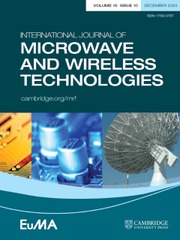No CrossRef data available.
Design and optimization of MIMO dielectric resonator antenna with high gain and circular polarization features using machine learning algorithms
Published online by Cambridge University Press: 05 June 2025
Abstract
This paper elaborates the design and analysis of cross-aperture-coupled twin port ceramic radiator. Stimulation of alumina ceramic using a cross slot helps to produce circular waves within 7.35–7.8 GHz. The polarization diversity concept helps to improve the separation level by above 25 dB. Loading of double negative unit cell made metasurface (MS) improves the antenna gain over 11.5 dBi within the working spectrum. Machine learning (ML) techniques, i.e. Decision Tree and Random Forest are utilized to predict the |S11|/Axial ratio parameters. Experimental verification/ML prediction and optimized simulated consequences confirm that the structured radiator works efficiently between 7.21 and 8.2 GHz with over 25 dB isolation between the ports. Directive pattern and decent values of (MIMO) parameters make the radiator applicable for the 6G communication system.
Keywords
Information
- Type
- Research Paper
- Information
- International Journal of Microwave and Wireless Technologies , Volume 17 , Issue 3 , April 2025 , pp. 504 - 513
- Copyright
- © The Author(s), 2025. Published by Cambridge University Press in association with The European Microwave Association.


